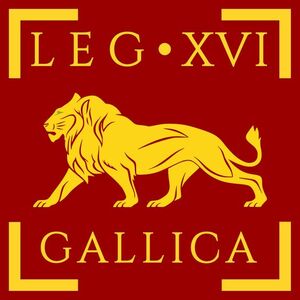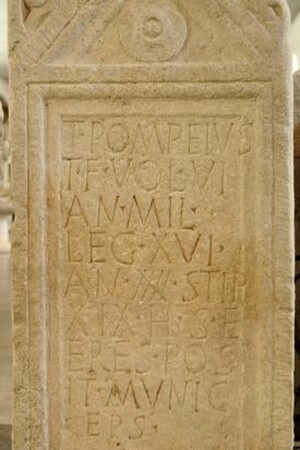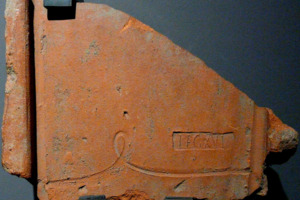Roman Legion - Legio XVI Gallica
Legio XVI Gallica (Sixteenth Gallic Legion) - a Roman legion formed by Octavian Augustus in 40-41 BCE to combat Sextus Pompeius, son of Pompey the Great, who had seized Sicily and threatened Rome's grain supply.
Dates of existence: 41/40 BC – 70 AD
Emblem: Most likely a lion.
Nickname: Gallica (Gallic).
Battle Path
- Legio XVI Gallica was created by Octavian Augustus in 41/40 BCE to fight Sextus Pompeius, who had taken Sicily and threatened Rome's grain supply.
- In 36 BCE, after the defeat of Sextus Pompeius, Legio XVI Gallica was probably transferred to Africa, where several coins with the inscription LEG XVI and a portrait of a very young Octavian were found.
- After Octavian Augustus' victory over Mark Antony at the Battle of Actium in 31 BCE, Legio XVI Gallica was moved to the Rhine frontier. German scholars suggest that from 15 BCE to 9 CE, detachments of Legio XVI Gallica were in the Augsburg area in Raetia (the westernmost Danubian province of Rome). In 1959, a Hagenau-type helmet with an inscription mentioning the legion was discovered at a gravel quarry near Neu-Ulm: "Le(gio) XVI P(ubli) Aur(eli) IR(?)I (centuria) Arabi M(arci) Munati."
- In 13 BCE, Legio XIV Gemina and Legio XVI Gallica were moved to a new camp in Mogontiacum (modern Mainz, Germany).
- From 12 to 9 BCE, Legio XVI Gallica participated in the campaigns of Drusus the Elder in Germany.
- In 9 BCE, soldiers of Legio XIV Gemina and Legio XVI Gallica built a cenotaph in Mogontiacum (modern Mainz, Germany) in honor of the deceased Drusus the Elder.
- In 6 CE, Emperor Tiberius used Legio XVI Gallica in his military campaign against the Marcomannic king Maroboduus, but he was unable to complete the campaign due to the outbreak of an anti-Roman uprising in Pannonia.
- In 9 CE, after the destruction of Legio XVII, Legio XVIII, and Legio XIX in the Battle of Teutoburg Forest, Legio XVI Gallica temporarily occupied the Altar of the Ubii (modern Cologne, Germany) and prevented the Germanic tribes from attacking Belgica (a Roman province in the northeastern part of Roman Gaul, covering modern-day France, Belgium, Luxembourg, the Netherlands, and Germany). Soon after, Legio XVI Gallica returned to its base in Mogontiacum (modern Mainz, Germany).
- From 14 to 16 CE, Legio XVI Gallica fought Germanic tribes as part of Germanicus' Roman army.
- In the winter of 40/41 CE, the governor of Upper Germany, the future Emperor Sulpicius Galba, defeated the Chatti, a Germanic tribe living near the base of Legio XVI Gallica in Mogontiacum. Although there are no mentions of Legio XVI Gallica's participation, it likely took part in Galba's campaign.
- In 43 CE, Emperor Claudius moved Legio XVI Gallica to Novaesium (modern Neuss, Germany), replacing Legio XX Valeria Victrix, which had been transferred for the invasion of Britain.
- In 67 CE, several Roman governors - in Africa (Governor Clodius Macer) and Gallia Lugdunensis (Governor Gaius Julius Vindex) - supported the governor of Tarraconensis Spain, Sulpicius Galba, in his revolt against Emperor Nero. Legio XVI Gallica, part of the lower German legions, was sent by Nero to suppress Vindex's uprising. Vindex was defeated and killed, but Galba still became emperor in the summer of 68 CE (the Year of the Four Emperors).
- Emperor Galba disliked the Rhine legions and remembered their involvement in Vindex's fate, so in January 69 CE, the lower German legions, including Legio XVI Gallica, declared their governor, Vitellius, as emperor. A detachment of Legio XVI Gallica went to Rome with him and participated in both battles of Bedriacum. Vitellius won the first battle and became emperor but lost the second battle, and Vespasian became the new emperor of Rome.
- At this time, the Batavian Revolt against Roman rule broke out in Lower Germany in 70 CE. The remaining Roman forces in Lower Germany were insufficient to suppress the revolt. In the winter of 69/70 CE, parts of Legio V Alaudae and Legio XXII Primigenia were defeated near Nijmegen, and their remnants were besieged in Castra Vetera (modern Xanten, Germany). An attempt to rescue these forces with Legio I Germanica, Legio XVI Gallica, Legio V Alaudae, and Legio XXII Primigenia failed.
- In March 70 CE, the remnants of Legio V Alaudae and Legio XXIIPrimigenia surrendered to the rebels and were massacred. Shortly after, Legio I Germanica and Legio XVI Gallica also surrendered to the rebels near Bonn.
- A few months later, the new emperor Vespasian gathered a strong army led by Quintus Petillius Cerialis. Cerialis and his new army suppressed the Batavian revolt and restored Roman control over the Rhine region.
- Legio V Alaudae and Legio XV Primigenia were not reinstated due to their disgrace. Instead, the legionaries of Legio IV Macedonica and Legio XVI Gallica were renamed and reinforced with new recruits. Legio IV Macedonica was now called IV Flavia Felix, and Legio XVI Gallica was now called Legio XVI Flavia Firma. The remnants of Legio I Germanica were added to Legio VII Galba and renamed Legio VII Gemina.
Related topics:
List of Roman Legions, Legion, Legionnaire, Legio XVI Flavia Firma, Legio XIV Gemina, Octavian Augustus, Legio IV Macedonica, Legio XXII Primigenia, Legio I Germanica
Literature
1. Jona Lendering. Legio XVI Gallica.
2. R. Kanya. Brief History of Various Legions.
3. Dando-Collins. "Legions of Rome. The Complete History of All the Legions of the Roman Empire." Moscow: Tsentrpoligraf, 2017.
4. Emil Ritterling. Paulys Realencyclopädie der classischen Altertumswissenschaft. Legio (XVI). Band XII,2. — Stuttgart: J.B. Metzler, 1925. — S. 1761—1764.
5. Aufstieg und Niedergang der römischen Welt (ANRW). Teil II Bd. 5/1 / Hildegard Temporini, Wolfgang Haase, (Hrg). — Berlin : New York: de Gruyter, 1976.
6. Abgetaucht, aufgetaucht — Flußfundstücke. Aus der Geschichte. Mit ihrer Geschichte / Hans-Peter Kuhnen (Hrsg.). — Trier: Rheinisches Landesmuseum Trier, 2001. — 202 S.





